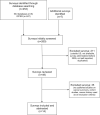Identifying and describing cancer survivors: Implications for cancer survivorship research and clinical care
- PMID: 34597418
- PMCID: PMC8738118
- DOI: 10.1002/cncr.33937
Identifying and describing cancer survivors: Implications for cancer survivorship research and clinical care
Abstract
Background: Gathering information directly from cancer survivors has advanced our understanding of the cancer survivorship experience. However, it is unknown whether surveys can distinguish important subgroups of cancer survivors. This study aimed to describe the current landscape of survey questions used to identify and describe cancer survivors in national cross-sectional studies.
Methods: Using publicly available databases, the authors identified national cross-sectional surveys used in the United States within the past 15 years that included a question on self-reported history of cancer. After abstracting questions and response items used to identify cancer survivors, they conducted a descriptive analysis.
Results: The authors identified 14 national cross-sectional surveys, with half administered to the general population and the other half administered to cancer survivors. The most common question used to identify cancer survivors was "Have you ever been told by a doctor or other health professional that you had cancer?" Most surveys had questions asking participants to identify a single cancer type (n = 11), multiple prior cancer diagnoses or types (n = 11), and the time from diagnosis (n = 12). Treatment questions varied from active treatment status to specific treatments received. Questions addressing cancer stage (n = 2), subtypes (n = 1), metastatic status (n = 3), and recurrence (n = 4) were less frequently included.
Conclusions: There is no standard method for assessing self-reported cancer history, and this limits the ability to distinguish among potentially important subgroups of survivors. Future cross-sectional surveys that capture nuanced data elements, such as cancer types, stages/subtypes, metastatic/recurrent status, and treatments received, can help to fill important gaps in cancer survivorship research and clinical care.
Keywords: cancer survivors; cross-sectional studies; health surveys; surveys and questionnaires.
© 2021 The Authors. Cancer published by Wiley Periodicals LLC on behalf of American Cancer Society. This article has been contributed to by US Government employees and their work is in the public domain in the USA.
Conflict of interest statement
The authors made no disclosures.
Figures
Comment in
-
Switching the scope from "how to identify cancer survivors" to "who is participating in cancer survivorship research": A proposal for a new focus.Cancer. 2022 May 15;128(10):2036-2037. doi: 10.1002/cncr.34130. Epub 2022 Feb 8. Cancer. 2022. PMID: 35132621 No abstract available.
References
-
- Statistics, graphs and definitions. National Cancer Institute. Updated December 9, 2020. Accessed December 2, 2020. https://cancercontrol.cancer.gov/ocs/statistics#definitions
-
- American Cancer Society . Cancer Treatment & Survivorship Facts & Figures 2019‐2021. American Cancer Society; 2019.
MeSH terms
Grants and funding
LinkOut - more resources
Full Text Sources
Medical
Miscellaneous


